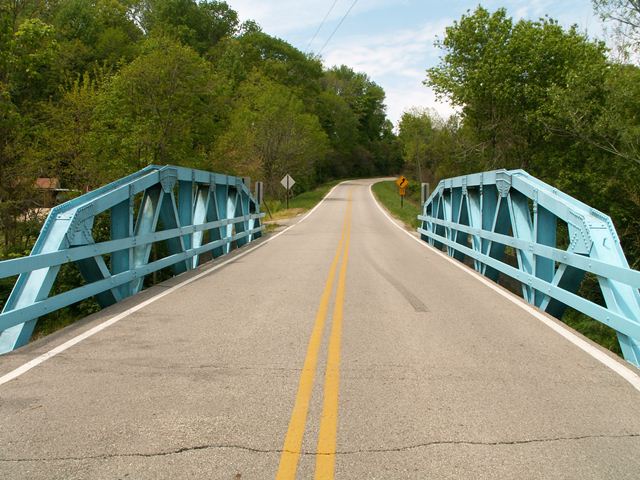We Recommend:
Bach Steel - Experts at historic truss bridge restoration.
BridgeHunter.com Phase 1 is released to the public! - Visit Now
Paint Creek 4 Mile Road Bridge
CR-45 Bridge

Primary Photographer(s): Nathan Holth
Bridge Documented: May 7, 2006
Rural: Preble County, Ohio: United States
1960 By Builder/Contractor: Champion Bridge Company of Wilmington, Ohio
Not Available or Not Applicable
64.0 Feet (19.5 Meters)
73.2 Feet (22.3 Meters)
20 Feet (6.1 Meters)
1 Main Span(s)
6835414

View Information About HSR Ratings
Bridge Documentation
View Archived National Bridge Inventory Report - Has Additional Details and Evaluation
About This Unusual Bridge Design
This bridge is one of a number of unusual pony truss bridges built by the Champion Bridge Company in Preble County well after the truss bridge era had come to a close in most of the country. They are noted for their use of modern design such as rolled beams and omission of any built-up beams, while continuing the older, traditional use of rivets for connections. The riveted connections are a contrast to the welded truss bridges that were built in Ohio around the same time as these bridges and continue to be built in the present day. The riveted connections add to the visual qualities of the bridges, compared to the plain-looking welded connections.
The 1950s and 1960s were the final home run of a transition from aesthetic bridge design to "purely functional" bridge design, where the "art" in bridge building came to a close thus ending a tradition of beauty in bridges. As a result, this bridge, with a 1958 construction date, represents the end of this transition. While it still has aesthetic value, mainly in the old-fashioned rivets, it is quite plain, with its rolled i-beams.
About the CR-45 Bridge
This bridge was missing a plaque at one end. Otherwise it is a traditionally composed example of this bridge design.
Information and Findings From Ohio's Historic Bridge InventorySetting/Context The bridge carries a 2 lane road over a stream in a sparsely developed, rural setting. Physical Description The 1 span, 73'-long, rivet-connected Warren pony truss bridge has polygonal upper chord and verticals. The members are rolled sections. Summary of Significance The ca. 1950 Warren pony truss is a late example of its type/design with no distinguishing features. It has riveted connections, typical of Warren trusses from about 1900 to the 1940s when riveted connections
began to be phased out in favor of welded connections. The weld-connected Warren trusses continue to be a popular bridge type/design on county roads in Ohio. The survey has identified more than 500 pre-1961 Warren pony truss
bridges, making them the most common truss type/design surviving in the state. This example is not historically significant for its technology or context. More distinguished examples better represent the significance of the
type/design in the development of the state's road systems. The not eligible recommendation of the prior inventory remains appropriate. Bridge Considered Historic By Survey: No |
![]()
Photo Galleries and Videos: Paint Creek 4 Mile Road Bridge
Bridge Photo-Documentation
Original / Full Size PhotosA collection of overview and detail photos. This gallery offers photos in the highest available resolution and file size in a touch-friendly popup viewer.
Alternatively, Browse Without Using Viewer
![]()
Bridge Photo-Documentation
Mobile Optimized PhotosA collection of overview and detail photos. This gallery features data-friendly, fast-loading photos in a touch-friendly popup viewer.
Alternatively, Browse Without Using Viewer
![]()
Maps and Links: Paint Creek 4 Mile Road Bridge
Coordinates (Latitude, Longitude):
Search For Additional Bridge Listings:
Bridgehunter.com: View listed bridges within 0.5 miles (0.8 kilometers) of this bridge.
Bridgehunter.com: View listed bridges within 10 miles (16 kilometers) of this bridge.
Additional Maps:
Google Streetview (If Available)
GeoHack (Additional Links and Coordinates)
Apple Maps (Via DuckDuckGo Search)
Apple Maps (Apple devices only)
Android: Open Location In Your Map or GPS App
Flickr Gallery (Find Nearby Photos)
Wikimedia Commons (Find Nearby Photos)
Directions Via Sygic For Android
Directions Via Sygic For iOS and Android Dolphin Browser
USGS National Map (United States Only)
Historical USGS Topo Maps (United States Only)
Historic Aerials (United States Only)
CalTopo Maps (United States Only)

